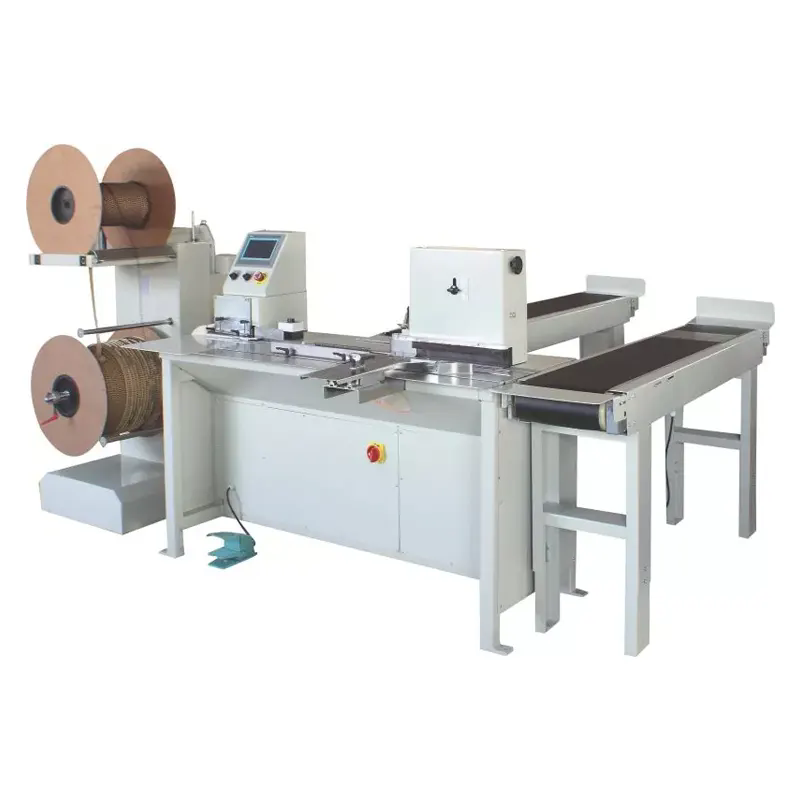Notebook Closing Machine: Revolutionizing the Bookbinding Process
2025-05-12
In the world of bookbinding and printing, efficiency and precision are key to producing high-quality products. One of the most crucial steps in the production of notebooks, diaries, and other bound materials is the closing process, which involves securing the pages to the cover. A Notebook Closing Machine plays an integral role in this phase, ensuring that the binding is both secure and aesthetically pleasing. This machine has become a staple in the manufacturing of notebooks, offering improved speed, accuracy, and consistency.

What is a Notebook Closing Machine?
A Notebook Closing Machine is a specialized piece of equipment used in the final stages of notebook production. It is designed to attach the covers to the pages securely, typically using a binding method such as glue or stitching. The machine operates by applying the binding material to the spine of the notebook, pressing it together, and then ensuring the cover is perfectly aligned with the pages.
Notebook closing machines come in various types, each suited to different production needs. Some machines focus on hot-melt glue binding, while others may use more traditional methods like thread stitching or wire-o binding. Regardless of the method, these machines are essential for delivering the high-quality finish expected in today’s notebook and book manufacturing.
The Role of a Notebook Closing Machine in the Production Line
The notebook closing process is a critical step that demands both precision and speed. Before this step, the individual pages of the notebook are printed, trimmed, and stacked. At this stage, the pages are still loose, and the notebook is not yet functional.
1. Alignment and Securing the Pages:
The first task of the notebook closing machine is to align the pages and covers to ensure uniformity and consistency across large batches. Misalignment can lead to poor-quality products, so an automatic system is essential for precise placement.
2. Binding Process:
Depending on the machine type, the closing mechanism involves either glue application, stitching, or clamping. For glue binding, the machine typically uses a heated system to melt the adhesive, ensuring a strong and durable bond between the pages and the cover. For stitched bindings, needles are used to sew the spine together, while wire-o machines clamp the pages securely.
3. Pressing and Drying:
After binding, the notebook is subjected to pressing. This ensures that the binding material sets properly and that the spine is tightly adhered to the cover. In the case of glue binding, the notebooks may pass through a drying station to solidify the adhesive and allow for proper adhesion.
4. Quality Control:
The machine may also include a quality control function that checks for defects in the binding process. This can include checks for proper alignment, even glue distribution, and spine durability. Automated systems can detect any issues and either alert the operator or reject defective notebooks from the production line.
Types of Notebook Closing Machines
1. Hot Melt Glue Binding Machines:
One of the most common methods for binding notebooks, hot melt glue binding involves the application of a heated adhesive to the spine of the notebook. Once the glue is applied, the machine presses the pages and cover together and allows the glue to cool, forming a permanent bond. This method is fast, reliable, and provides a professional finish.
2. Stitching Machines:
For notebooks that require thread stitching, these machines use needles to stitch through the spine of the pages. The stitching method provides a more traditional and durable binding, ideal for notebooks with thicker or more pages. It also gives the notebook a distinct, handmade feel, which is popular for premium products.
3. Wire-O Binding Machines:
Wire-O binding is commonly used for spiral-bound notebooks and diaries. This type of machine uses a wire coil that is threaded through the holes punched in the pages and then secured at the spine. It provides a flexible opening and is often used for notebooks that need to lay flat, such as planners and reference books.
4. Cold Binding Machines:
Cold binding machines are a more modern option that uses a special adhesive that does not require heating. This method can be more energy-efficient and is often used for smaller runs or specific applications where hot glue binding is not suitable.
Advantages of Using a Notebook Closing Machine
1. Efficiency and Speed:
One of the primary advantages of using a notebook closing machine is the increase in production speed. Manual binding methods are labor-intensive and time-consuming, while automated machines can bind hundreds or even thousands of notebooks in a fraction of the time.
2. Consistency and Quality:
Automated systems ensure consistent binding quality across large batches of notebooks. With manual methods, variations in glue application, stitching tension, or alignment can lead to uneven results. The machine removes these inconsistencies, ensuring that every notebook is bound with precision.
3. Cost-Effective:
While the initial investment in a notebook closing machine may be significant, the long-term savings are substantial. By increasing production speed, reducing the need for manual labor, and minimizing waste, manufacturers can significantly reduce overall production costs.
4. Customization:
Many notebook closing machines offer customization options, allowing manufacturers to adjust the binding process to fit specific needs. This can include adjusting glue flow, stitching patterns, or wire sizes, providing flexibility in the types of notebooks that can be produced.
5. Durability and Longevity:
Notebook closing machines are built for long-term use, often incorporating robust materials and components that can withstand continuous production cycles. This durability ensures that manufacturers can rely on the equipment for years without frequent repairs or replacements.
Conclusion
A Notebook Closing Machine is an essential piece of equipment in the production line of notebooks, diaries, and other bound materials. It offers numerous benefits, from increased efficiency and production speed to consistent quality and cost savings. By automating the binding process, manufacturers can meet the high demands of the market while maintaining the quality and durability that customers expect.
Whether you are a large-scale manufacturer or a small print shop, investing in a notebook closing machine is a smart decision that can streamline your production process, improve the final product, and help you stay competitive in a fast-paced industry.


